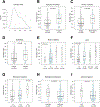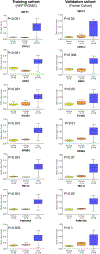DNA methylation-based prognosis and epidrivers in hepatocellular carcinoma
- PMID: 25645722
- PMCID: PMC12337117
- DOI: 10.1002/hep.27732
DNA methylation-based prognosis and epidrivers in hepatocellular carcinoma
Abstract
Epigenetic deregulation has emerged as a driver in human malignancies. There is no clear understanding of the epigenetic alterations in hepatocellular carcinoma (HCC) and of the potential role of DNA methylation markers as prognostic biomarkers. Analysis of tumor tissue from 304 patients with HCC treated with surgical resection allowed us to generate a methylation-based prognostic signature using a training-validation scheme. Methylome profiling was done with the Illumina HumanMethylation450 array (Illumina, Inc., San Diego, CA), which covers 96% of known cytosine-phosphate-guanine (CpG) islands and 485,000 CpG, and transcriptome profiling was performed with Affymetrix Human Genome U219 Plate (Affymetrix, Inc., Santa Clara, CA) and miRNA Chip 2.0. Random survival forests enabled us to generate a methylation signature based on 36 methylation probes. We computed a risk score of mortality for each individual that accurately discriminated patient survival both in the training (221 patients; 47% hepatitis C-related HCC) and validation sets (n = 83; 47% alcohol-related HCC). This signature correlated with known predictors of poor outcome and retained independent prognostic capacity of survival along with multinodularity and platelet count. The subset of patients identified by this signature was enriched in the molecular subclass of proliferation with progenitor cell features. The study confirmed a high prevalence of genes known to be deregulated by aberrant methylation in HCC (e.g., Ras association [RalGDS/AF-6] domain family member 1, insulin-like growth factor 2, and adenomatous polyposis coli) and other solid tumors (e.g., NOTCH3) and describes potential candidate epidrivers (e.g., septin 9 and ephrin B2).
Conclusions: A validated signature of 36 DNA methylation markers accurately predicts poor survival in patients with HCC. Patients with this methylation profile harbor messenger RNA-based signatures indicating tumors with progenitor cell features.
© 2015 by the American Association for the Study of Liver Diseases.
Conflict of interest statement
Dr. Battiston is on the speakers’ bureau for Bayer. Dr. Mazzaferro is on the speakers’ bureau for and received grants from Bayer. He is on the speakers’ bureau for BTG and Ipsen. Dr. Llovet consults for and received grants from Bayer, Bristol-Myers Squibb, and Boehringer Ingelheim. He consults for Lilly, Blueprint, Celsion, Novartis, and GlaxoSmithKline.
Figures





References
-
- Murray CJL, Vos T, Lozano R, Naghavi M, Flaxman AD, Michaud C, et al. Disability-adjusted life years (DALYs) for 291 diseases and injuries in 21 regions, 1990–2010: a systematic analysis for the Global Burden of Disease Study 2010. Lancet 2013;380:2197–2223. - PubMed
-
- European Association for the Study Of The Liver, European Organisation for Research and Treatment of Cancer. EASL-EORTC Clinical Practice Guidelines: management of hepatocellular carcinoma. J Hepatol 2012;56:908–943. - PubMed
Publication types
MeSH terms
Associated data
- Actions
- Actions
Grants and funding
LinkOut - more resources
Full Text Sources
Other Literature Sources
Medical
Molecular Biology Databases
Miscellaneous
